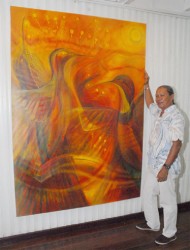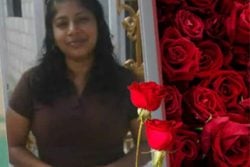Prior to a few months ago I had not seen George Simon in quite as few years. We had not spoken at length with each other for an even longer period… probably fifteen years or so.
I had first met George during the 1980s (the exact year escapes me now) in London. He had travelled from Guyana as part of a group of Guyanese artists to do an exhibition of their various works in London. I remember little of George’s works from those days and only came to be aware of how important an artist he was several years later.
From an artistic standpoint what impressed me most about that travelling group of artists were the little balata life-like figures turned out by George Tancredo, one of the group. I can still remember the artist sitting on the stairway heading to the Gallery at the Commonwealth Institute fashioning his balata figures.
What drew me to George all those years ago was the sense I got that he was a ‘deep and serious’ artist, that he was more concerned with substance than with form. I remember that I had met other Guyanese artists and that George, Aubrey Williams, Bernadette Persaud and Hazel Shury all struck me as being warm personalities.

After London, George and I had made several promises to ‘catch up’ and all of those promises had been broken by one or the other of us. The times were different. We were both back in Guyana pursuing our separate ‘hustles.’
We finally agreed to ‘sit down together’ during an encounter in the editorial department of the Stabroek News a few months ago. I told him that the newspaper was in the process of publishing the final issue of The Guyana Review for 2013 and that I would want to do an interview with him.
A few days later we met at Castellani House… that was during Amerindian Heritage Month. George, along with Oswald Hussein and Victor Captain were exhibiting their work. It was the largest collection of George’s work that I had ever seen. Two things struck me about his work; first, the images appeared to be deeply rooted in his Amerindian heritage; secondly, there was something about those images that reminded me of the pre-Colombian symbolism that I had seen in the work of the late Aubrey Williams.
George told me that he had been living in Mexico for some time. The fact that his work was being displayed as part of Amerindian Heritage Month impressed me. I felt that it added something substantial to an occasion that had been ‘going through the motions’ for some years. I told George how impressed I was and he said that it was important that Guyanese artists share their work with the rest of the society.
Over lunch at a Brazilian restaurant we spoke about a number of things, Guyanese politics, the condition of the creative arts in Guyana…preserving the Amerindian heritage and the state of Amerindian communities. Though I had never known George to be an overly demonstrative person, he appeared to have become even more contemplative during those years that I had not seen him.
George had traveled during those years…in the Americas, Africa and in Europe and the former travels had filled him with a more profound sense of self. Those travels seemed to have connected him with a sense of his own history, his own identity. He wore it like the profound accomplishment it was.
George Simon was born in the Arawak Village of Pakuri on the Mahaica River, a place with a reputation for creative work. For as long as I have known him, which is over a quarter of a century, I had encountered evidence in the publicity associated with his work of a commitment to his heritage. He always seemed to me to possess a bearing of intense confidence as if he was seeking to reflect the pride and the dignity of the entire Guyanese Amerindian community. There was – and still is – a bearing to George Simon.
He had become known for his work with the Lokono Group which he had mentored and which, according to the brochure published to coincide with the ‘Silent Witness’ exhibition, identified with “the elements and features of their inmterior environment over the last twenty years.” The group had made a creative statement in 1998 at their exhibition at the Venezuelan Cultural Centre titled ‘Artists for the Environment.’
Over our Brazilian lunch George had spoken to me about his perceptions of the condition of the Amerindians and it seemed to me that he was concerned about a great deal more than the environment…he wanted to see changes in the whole condition of the Amerindians. The change, he insisted, had to do with the condition of their entire lives.
I remember that it was only after he had walked me through the ‘Silent Witness’ exhibition that the magnitude of his contribution to to the collective creativity of his people and to that of Guyana as a whole struck me. It reminded me of a view which I have always held, which is, that one of the real failings of our country has been our propensity to place the greater emphasis on the lesser things… like our divisive politics and our destructive racial cleavage… ahead of our more worthwhile gifts and virtues like the richness that inheres in the diversity of our culture and our creative gifts…like the works of George Simon.
All of what George said to me during our meeting earlier this year and during our Brazilian lunch and our stroll through the Castellani gallery viewing his work tells me that he too wants us to re-order our priorities before our present course consume us.
Arnon Adams




